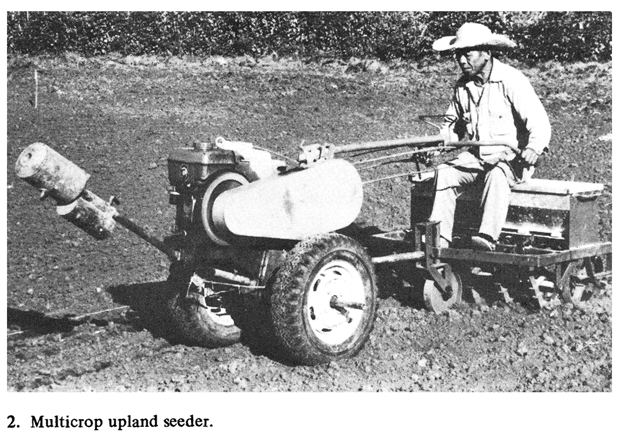IRRI researchers are playing a vital role in identifying the socioeconomic constraints to rice production and in testing the ability of farmers to respond once the constraints are removed. Ultimately, social and political leaders must be motivated to take steps to remove such constraints. A farmer must be able to make more money if he accepts a new technology. His risks must be reduced and he must have a ready market for his produce.
 Plant scientists suggest that under ideal conditions modern rice varieties have the biological potential to produce 3 to 10 times the yields commonly obtained by farmers. In temperate regions the potential is 15 to 17 t/ha. In the tropics it is somewhat lower – 13 to 15 t/ha – because of higher respiration rates. Such yield figures dwarf average national rice yields and underscore the extent of a large potential-performance gap.
Plant scientists suggest that under ideal conditions modern rice varieties have the biological potential to produce 3 to 10 times the yields commonly obtained by farmers. In temperate regions the potential is 15 to 17 t/ha. In the tropics it is somewhat lower – 13 to 15 t/ha – because of higher respiration rates. Such yield figures dwarf average national rice yields and underscore the extent of a large potential-performance gap.
Farmers in tropical countries suffer most from this gap. There would be no cereal food deficiencies in the tropics if rice yields there and in the subtropics were as high as those in Japan, Australia, Europe, and the United States. On the contrary, there would be food surpluses. Adequate food would be available for double–even triple–the current populations in the tropics.
The average rice yields of Japanese farmers are 30 to 40% of the potential yield that can be produced under ideal conditions. But in India, the Philippines, and Indonesia, farmers produce only an average 12 to 15% of the potential yield for the tropics. Reduction of this potential-performance gap is our greatest challenge.
Rice scientists have the responsibility of identifying reasons for the wide yield gap and of ascertaining means of reducing it.
Research shows three primary factors to be responsible for this wide yield gap.
First are the physical-environmental constraints, most of which either are uncontrollable by man or require excessive cost for their removal. Climatic extremes of cold and hot, or wet and dry are examples. The low temperatures in Korea and the high ones in Pakistan are not subject to easy manipulation. In areas where floating rices are grown, annual floods will likely continue. Likewise, strongly acid sulfate soil areas will probably remain acid because the costs of reducing their acidity are prohibitive.
Second are the physical and biological constraints, which are most severe in the tropics, but which are controllable if appropriate technology is available. Population pressures have forced the cultivation of some land areas with poor soil. The monsoon type climates of the tropics bring alternate periods of deficit and excess of water. Diseases and insect pest pressures are much more severe in tropical environments than in temperate regions. Furthermore, favorable year-round temperatures encourage these pests.
These physical-biological constraints are subject to at least partial removal through improved technologies and management practices. Disease and insect pests can be controlled. Varieties tolerant of deficiencies and excesses of water and of toxic soils are on the horizon. And more efficient fertilizer and irrigation practices are being developed.
The third gap-producing factors are the socioeconomic constraints faced by the rice farmer in the tropics. His input supply and distribution systems are imperfect and his input costs are relatively high. The system for the distribution of irrigation water is often inefficient and beyond his control. And his financial resources are costly and subject to control by others. In addition, his sources of information on improved practices may be undependable or even erroneous. All in all, he lacks the motivation to increase production.
Scientists at IRRI are working with counterparts in national programs to first identify yield constraints and then to remove them. Already we have learned that pest management and fertilizer practices are primary constraints over wide areas. But we have also discovered that no technology has as yet been developed to remove yield constraints over even wider areas. In the flood-prone regions of eastern India, for example, where adapted improved varieties and associated cultural practices are not yet available, yields have remained essentially constant over the past 15 years. This contrasts with the rapidly increasing yields and production in northwestern India where appropriate technology is available and is used by farmers.
IRRI researchers are playing a vital role in identifying the socioeconomic constraints to rice production and in testing the ability of farmers to respond once the constraints are removed. Ultimately social and political leaders must be motivated to take steps to remove such constraints. A farmer must be able to make more money if he accepts a new technology. His risks must be reduced and he must have a ready market for his produce.








